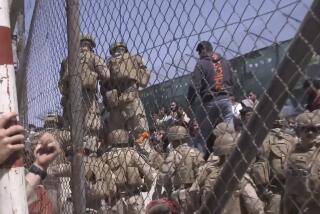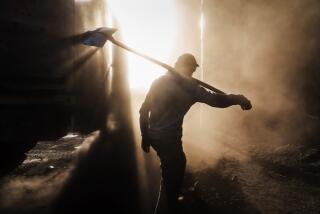Taliban May Surrender Key Southern Area
- Share via
CHAMAN, Pakistan — The Taliban appeared to be on the verge of surrendering a key area along Afghanistan’s southern border with Pakistan on Monday as hundreds of U.S. Marines took up positions near Kandahar, the Islamic movement’s only remaining stronghold.
A spokesman for an anti-Taliban tribal leader announced late Monday that Taliban forces in Spin Buldak, an Afghan border town, had agreed to hand over power in the surrounding area to a local leader of the Noorzai, one of the largest tribes in southern Afghanistan.
Abdul Khaliq, the tribal leader and an official in Afghanistan’s government before the Taliban took power, reached a tentative agreement with Taliban officials Monday for the surrender of the border town, said spokesman Zulmai Khan. A final decision on when the hand-over would occur and where Taliban forces would go was still being negotiated and was expected within days, he said.
Truck drivers carrying food aid across the border today turned around after finding the Taliban border post abandoned.
On Monday, the Taliban made no formal announcement. A key official of the movement told reporters at the border that there were no negotiations and no plans to surrender the town. Then he drove into Pakistan in what a friend said was a move to defect, making clear that he at least was not willing to hold out any longer.
Meanwhile, thousands of Taliban troops were moving to mountain redoubts to the east and west of Kandahar, according to reports from people who had seen them on the road. There was widespread speculation that they were headed to protect Osama bin Laden and members of his Al Qaeda terrorism network.
Many Taliban fighters appeared to be holed up in the area around Maruf, a village about 80 miles east of Kandahar in the rugged Afghan mountains near the Pakistani border. Maruf was formerly used as a hide-out by moujahedeen warriors who battled occupying Soviet forces during the 1980s.
During their first full day in Afghanistan, according to U.S. military officials, Marines from the new base at an airfield about 65 miles southwest of Kandahar were involved in a clash with Taliban forces. Marines in low-flying AH-1W Cobra helicopter gunships spotted a column of armored personnel carriers. Two Navy F-14 fighters attacked the column, leaving several vehicles in flames.
A spokesman for the U.S. Central Command in Tampa, Fla., said that the Taliban convoy, whose exact location was not disclosed, was not approaching the Marine base. It was unclear whether the Marine helicopters were involved in the firefight and whether there were casualties.
In Washington, Pentagon officials said the initial force of about 500 Marines who began landing in Afghanistan on Sunday will be joined by “hundreds, not thousands” more to tighten the squeeze on Taliban and Al Qaeda leaders by limiting their movements from the Kandahar area.
Defense Secretary Donald H. Rumsfeld and other Pentagon officials declined to elaborate further on the Marines’ mission, except to say that they will “establish, hold and protect” the airfield as a forward operating base, but not necessarily as the vanguard of a substantially larger American ground force.
U.S. Special Forces have been active in and around Kandahar for weeks, but having Marines on the ground will mean better “interdiction” of traffic around the crossroads city, especially traffic to Iran in the west and Pakistan in the east, Rumsfeld told reporters at a Pentagon briefing.
1,000 Marines to Be Flown Into Afghanistan
On Monday, helicopters and C-130 planes continued to airlift Marines from ships in the Arabian Sea, including the amphibious assault ship Peleliu, Pentagon spokeswoman Victoria Clarke said. Additional forces were being flown in from an unidentified land base, she said.
The troop movement was expected to take at least another day to complete, and about 1,000 Marines will be involved, Clarke said. The Marines are part of the 15th and 26th Marine expeditionary units. The 15th is based at Camp Pendleton, and the 26th is from Camp Lejeune, N. C.
Unconfirmed reports from travelers and anti-Taliban soldiers suggested that Marines also were taking up positions Monday at the main Kandahar airport, just a few miles from the city.
“From 4 o’clock in the morning, some airplanes were flying in the sky, and most were unloading equipment. Most were flying over the Kandahar airport, but some were in outlying rural areas,” said Haji Wali Mahmud, who was in touch with anti-Taliban commanders on the ground and is a relative of one prominent commander, Gul Agha Shirzai.
Similar information came from Malak Jailani, a tribal chief near the Pakistani border. Jailani said that he had sent between 200 and 300 men to fight with the antiTaliban forces attempting to advance on Kandahar and that he had been in contact with some of the commanders.
“There were American troops near the [main Kandahar] airport, this is sure,” he said.
In other developments:
* Gen. Richard B. Myers, chairman of the Joint Chiefs of Staff, told a Pentagon briefing that U.S. forces had bombed nine areas in Afghanistan on Monday, focusing on Al Qaeda and Taliban cave and tunnel complexes as well as Taliban military forces, primarily in areas around Kandahar and the eastern city of Jalalabad. He said that more than 90% of the airstrikes were against emerging targets, meaning either ground forces on the move or hide-outs where U.S. intelligence had indicated Taliban and Al Qaeda leaders might be.
The U.S. used about 110 strike aircraft, including about 85 fighters taking off from aircraft carriers, along with land-based fighters and long-range bombers, the Pentagon said.
* Two senior U.S. lawmakers who had just returned from the region warned that the location of many Afghan caves and tunnels could make it difficult to force out Taliban and Al Qaeda soldiers.
Sens. Carl Levin (D-Mich.), chairman of the Senate Armed Services Committee, and John W. Warner (R-Va.), the ranking minority member on the panel, said that many of the caves and tunnels are located in a 300-mile-long mountainous stretch near the border with Pakistan. Levin said the proximity means that the fugitives might be resupplied by sympathetic Pakistanis.
The senators noted that there are more than 100 roads and pathways linking the two countries and that some “escape holes” from the caves emerge only yards from the border.
Despite the Pentagon’s cautious statements about the Marines’ role in Afghanistan, a number of Afghans said they hoped that the Marines would help flush out the Taliban and Al Qaeda forces.
“The [anti-Taliban] Afghans can take care of Kandahar. They have leaders, they have educated people, they have arms,” said Abdul Malik, an aide to Hamid Karzai, an ethnic Pushtun tribal leader in the south. “But people like Osama and the terrorists--there must be a big force to fight with them, [and] the presence of the Marines will solve that.”
Many reports Monday were contradictory, signaling the chaos in southern Afghanistan. It was difficult to determine whether Taliban or anti-Taliban forces had the upper hand on the crucial road between the Pakistani border crossing at Chaman and Kandahar, about 50 miles to the northwest. Similarly it was hard to tell which way the anti-Taliban forces were attempting to move.
Taliban Official Makes His Move Into Pakistan
The confusion was encapsulated in an incident Monday afternoon that occurred at the Chaman crossing with the arrival of Najibullah Akhund, the Taliban chief of security for Spin Buldak.
Quickly surrounded by journalists and TV cameras, the blackturbaned Taliban official declared that there would be no negotiations about the surrender of the border town, a major transit point and smuggling center for trade through southwest Asia.
“We are not ready for negotiations,” he said. “We will fight to the end.” He then jumped in a car and drove to Pakistan.
Moments before making his “fight-to-the-end” statement, however, the Taliban official had confided to a close friend at the border post that he was defecting, said the friend, who requested anonymity.
Local traders crossing into Chaman late in the day said that many of the Taliban militia appeared to have given up their arms and left Spin Buldak.
Similarly uncertain was the status of the road between the Pakistani border and Kandahar. Anti-Taliban tribal chiefs and their aides boasted repeatedly that they held the road, but interviews with traders arriving at the border indicated that a detour had been set up by the Taliban and that there was fighting on the road.
Abdul Hashim, a businessman in the Pakistani city of Quetta, said he had been stopped by Taliban fighters close to a bridge about halfway between the border and Kandahar. He was told he could not drive farther and was directed on a long detour that eventually rejoined the main road only four miles north of Spin Buldak, he said. No heavy vehicles had arrived from Kandahar for the past two days, locals said.
Meanwhile, Pakistan added army soldiers to border crossings. The troops were given photographs and other information to help them recognize members of Al Qaeda.
At Chaman checkpoint, Pakistani guards checked the identity card of each person trying to cross. The stringent control was in sharp contrast to the usual lax checks carried out among people streaming in both directions.
It was not yet clear if and when the Taliban will be entirely dispersed and out of power, but there was a sense that with the surrender Sunday of the northern city of Kunduz, where thousands of Taliban were fighting, the endgame had begun.
“Once they lost Kunduz, that was a big blow for them,” said Ahmed Karzai. “They know it’s finished and there’s not a 1% chance. They know [Taliban leader] Mullah [Mohammed] Omar’s dreams are over.”
Times staff writers John Hendren, Esther Schrader and Paul Richter in Washington contributed to this report.
More to Read
Sign up for Essential California
The most important California stories and recommendations in your inbox every morning.
You may occasionally receive promotional content from the Los Angeles Times.













